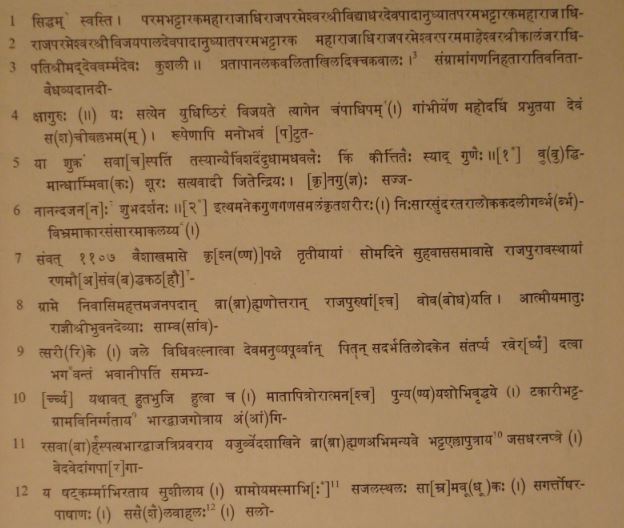|
INSCRIPTIONS OF THE CHANDELLAS OF JEJAKABHUKTI
TEXT1
[Metres: Verse 1 Śārdūlavikrīḍita ; vv. 3-7 Anushṭubh].

________________________
1 From facsimile in Ind. Ant., Vol. XVI.
2 Denoted by a symbol.
3 Here and in some cases below, which are not separately noted, the sign of punctuation is redundant.
4 That is, Karṇa. The consonant of the preceding  is not well formed. is not well formed.
5 The akshara in the brackets was originally omitted and was later on written below the line with an
arrow-mark to draw attention, but after the sign ofvisarga and not before where it is actually to be
supplied. This was not noted by Kielhorn.
6 Better read - -. -.
7 The reading of the consonant of this akshara, as also noted by Kielhorn, is not certain. In  that precedes, the vertical showing the mātrā in the third akshara is detached from it so as to look
like a daṇḍa.
that precedes, the vertical showing the mātrā in the third akshara is detached from it so as to look
like a daṇḍa.
8 This akshara, which was originally omitted, is writing below the line but without an arrow-mark to
draw attention to it as in n. 4, absent.
9 Kielhorn read  , but to me it appears to be as given here. What follows the point of , but to me it appears to be as given here. What follows the point of  is a
chisel-stroke and not the bend. is a
chisel-stroke and not the bend.
10 The reading of the first akshara of the name is not certain. Moreover, no sandhi is made here as
also in  that precedes. that precedes.
The Sanskrit form of the name that follows is  . .
11 This akshara is followed by two small dots vertically placed. It cannot be ascertained whether they
form she sign of the visarga
inserted subsequently or are merely stokes of the chisel.
12 This word is not known in dictionaries. The context, however, shows that vāha, water-ourse, is intended. See n. on this word in
No. 4, l. 11, above. The word vāha occurs also in No. 100, l. 10.
|